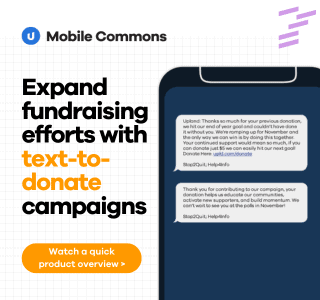Due to the personal nature of mobile devices, mobile marketers wield immense power: direct access to a customer’s attention span at all hours of the day.
In order to remain effective in the digital age, marketers have to accept the significant responsibility that comes with such power. This power encompasses everything from content, branding, incentives, channels, and segmentation data.
However, none of these responsibilities may be more important than the frequency of sending SMS messaging.
No matter how strong a company’s overall marketing strategy is, violating a customer’s personal space with too much content or too many updates results in immediate alienation. This shouldn’t come as a surprise, but the degree to which the data supports this analysis is extremely striking.
For those averse to reading data, the below deep dive reveals optimal mobile messaging frequency to max out around 10-12 messages sent per month.
For everyone else, here’s a look behind the curtain:
Data Analysis
The following graph shows the growth of two different mobile customer lists over a 45-day span. Now, take note that this chart shows completely anonymized data, and we’ve also normalized it to a 500K subscriber starting point.
Editor’s Note: Wish you had more subscribers? Check out 6 Ways to Grow Your SMS Marketing List for ideas you might be missing in your strategy.
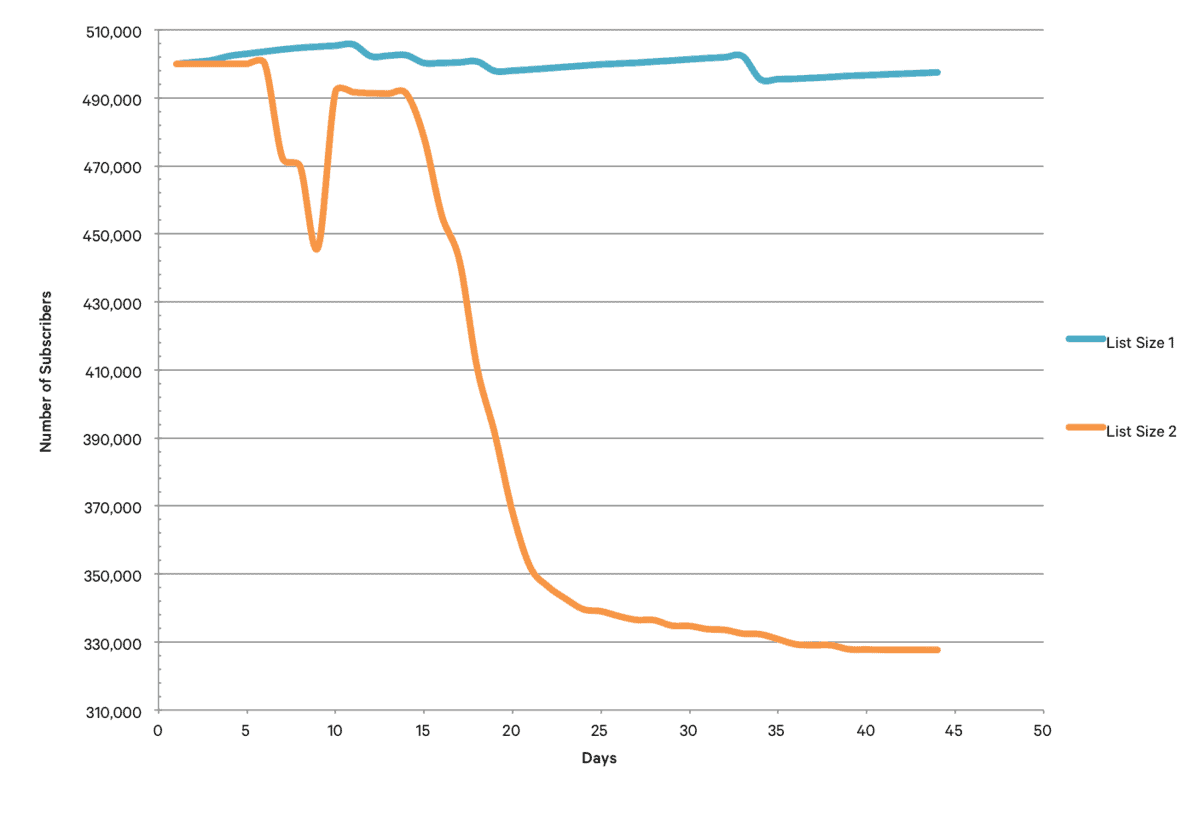
Starting with the same list size, both lists exhibited some degree of customer churn. For those not from the direct marketing world, “churn” happens when customers opt out of a marketing list, usually because they have already taken an action (e.g. making a purchase with a coupon) and no longer want to receive brand updates. Every direct marketing channel exhibits churn when marketers send an SMS message, as customers take the top-of-mind opportunity to unsubscribe. Though small churn is normal and expected, large churn is cause for immediate concern.
Looking at the graph, the blue marketer (“Blue”) retained 96% of their original customers, ending with ~480K on the list. Starting at the same point, the orange marketer (“Orange”) retained only 66%, finishing with ~327.5K. Clearly, Blue had much more success than Orange.
So, what exactly is going on?
Here’s the same data with added insight: each square represents the day when each marketer sent an SMS message to all customers subscribed to their list.
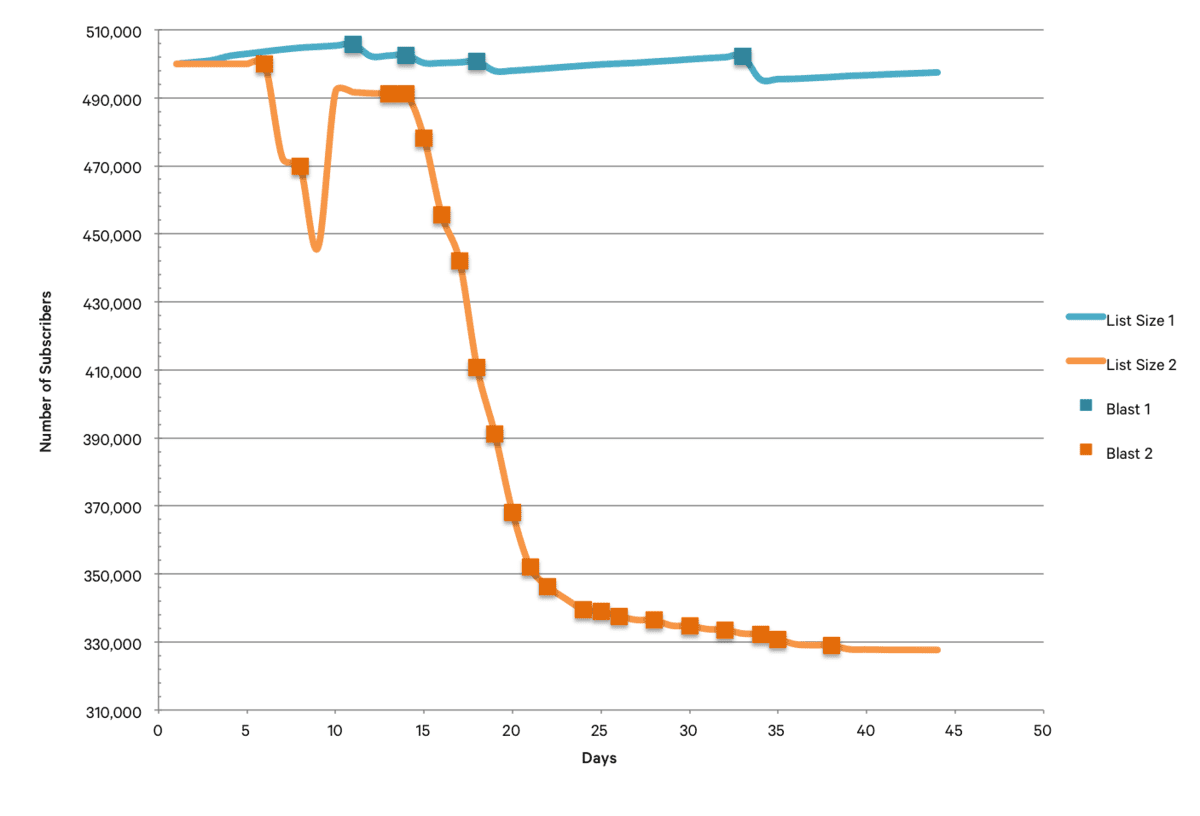
Now we’re getting somewhere. Over the same time frame, Blue sent 4 outbound blasts whereas Orange sent 29. If we look at the specific blast dates, we can calculate the average frequency for each marketer. Blue sent one message every nine days. Orange, one message every two days. That’s more than a 4X difference.
Back to our point about power, responsibility and mobile being a customer’s most personal device:
- Marketers hold a large degree of power being able to send an interruptive mobile message direct to customers at any time
- Marketers have the responsibility to provide value with those SMS messages so that customers have a reason to grant that degree of access
- Marketers who send SMS messages too often violate the personal nature of a customer’s phone – putting an onus on the marketer to provide tremendous value
In essence, Orange messaged customers too much. The value provided with each message was not sufficient to retain customers’ interest, and ultimately spurred ~40% to unsubscribe and put an end to their Orange brand relationship.
You can see that customers were initially open to receiving communication from Orange. However, once they started receiving a message every day, people unsubscribed. To illustrate this point, consider the cumulative unsubscribe rate for each marketer over the 45-day span.
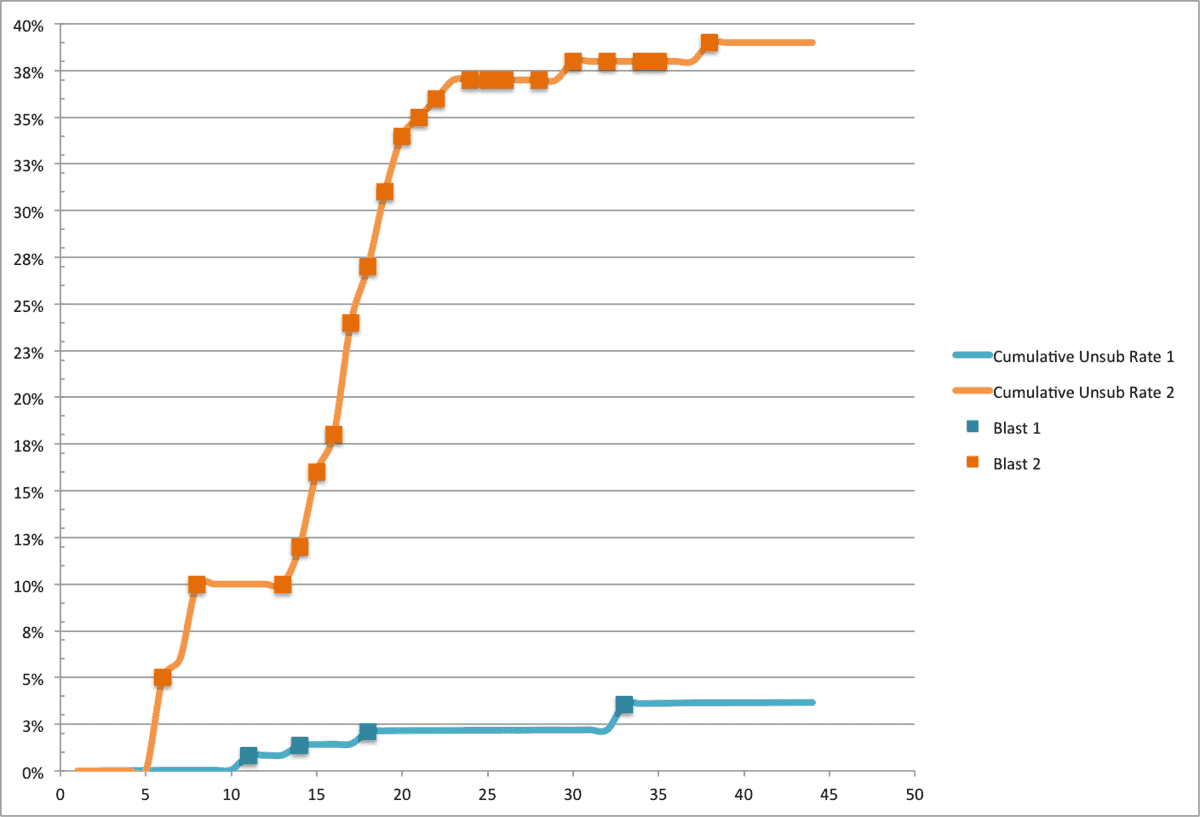
Unsubscribe rate for Orange remained under 10% until s/he started sending a message daily. Blue, on the other hand, sent less frequent SMS messages to limit unsubscribe rate significantly. Here’s another perspective showing the percent of customers who opted out following a blast:
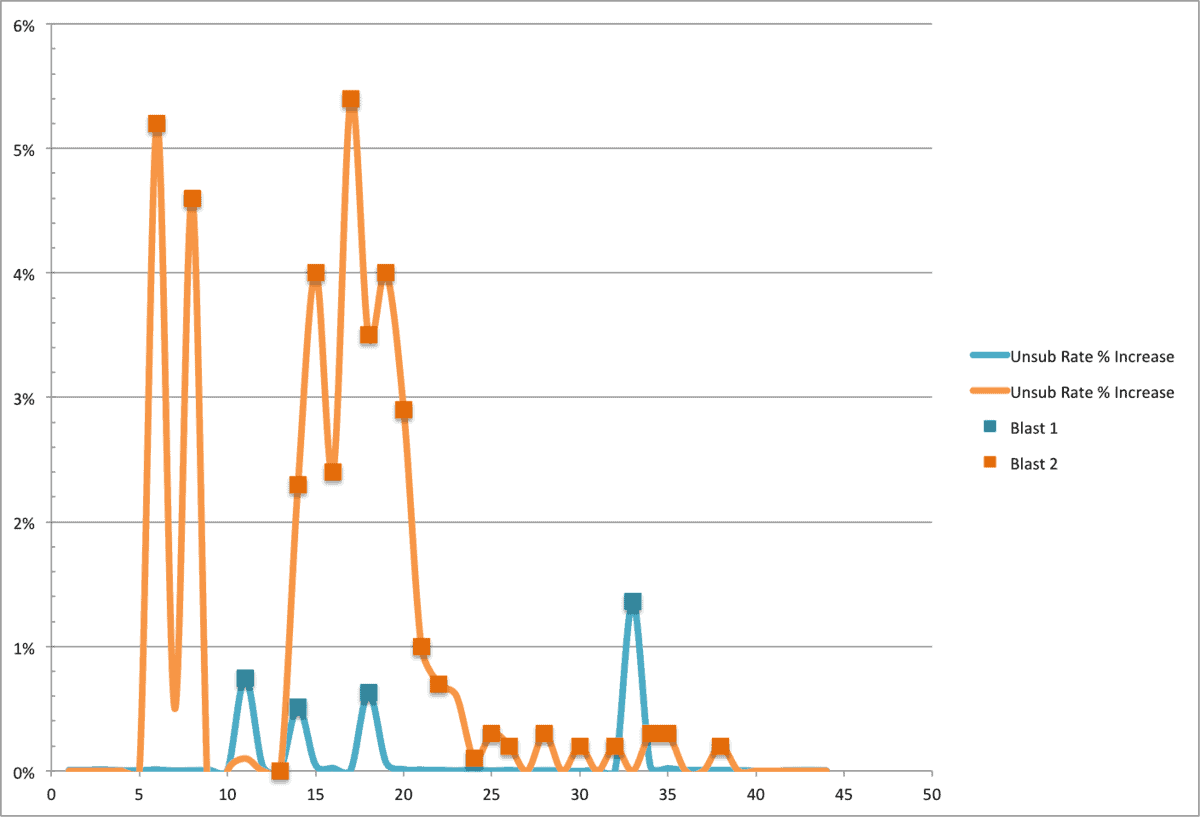
Whereas Orange had multiple blasts that resulted in an unsubscribe rate higher than 4%, Blues’s blasts broke 1% only once, with the majority falling under 0.7%.
To be clear, other factors beyond message frequency contribute to Orange and Blue’s respective successes, e.g. the content contained in each SMS message and the call to action advertising the promotion. That said, we can confidently postulate that message frequency impacts unsubscribe rate, and that marketers should strive to find a frequency that maximizes content sent while minimizing customer opt-outs.
The Value of Subscribers / Unsubscribers
A quick aside to discuss the all important “So What?” Unsubscribe rates matter because they directly impact customer lifetime value. We’ve discussed the financial implications of unsubscribers before, but to recap:
- All marketers have to pay a (large) cost to acquire customers. Often termed “CPA”, this encompasses costs like marketing collateral and incentives required to introduce a customer to a brand.
- Once acquired, marketers also pay to re-market to customers. Invariably, re-marketing is significantly cheaper than acquisition, as customers are already familiar with the brand.
- Customers, once acquired and via re-marketing, have value. They make purchases, refer other customers and positively promote the brand.
- Subtracting the cost of acquisition and re-marketing from the total value created over time produces “customer lifetime value” – the net of all present, future and referred value from each customer.
So, with a ~40% monthly unsubscribe rate, Orange has to pay again to acquire these customers. Plus, each subsequent blast no longer creates as much value given the smaller customer base. Blue, on the other hand, retains the entire customer base from which s/he can continue to extract more and more value. However, with only four blasts throughout the month, perhaps Blue leaves some value on the table.
Thus, the most successful marketers will find the ideal balance: the maximum number of messages sent per month (to increase value) that limits the impact on unsubscribe rate (to reduce cost).
The Optimal SMS Message Frequency
One last graph, which plots monthly customer outreach (by number of blasts sent in 30 days) against total unsubscribe rate at the end of the month. Our friend Blue would be on the bottom left, having sent four SMS messages with an unsubscribe rate below 4%. Orange would be on the top right, sending 29 SMS messages with an opt-out rate around 40%.
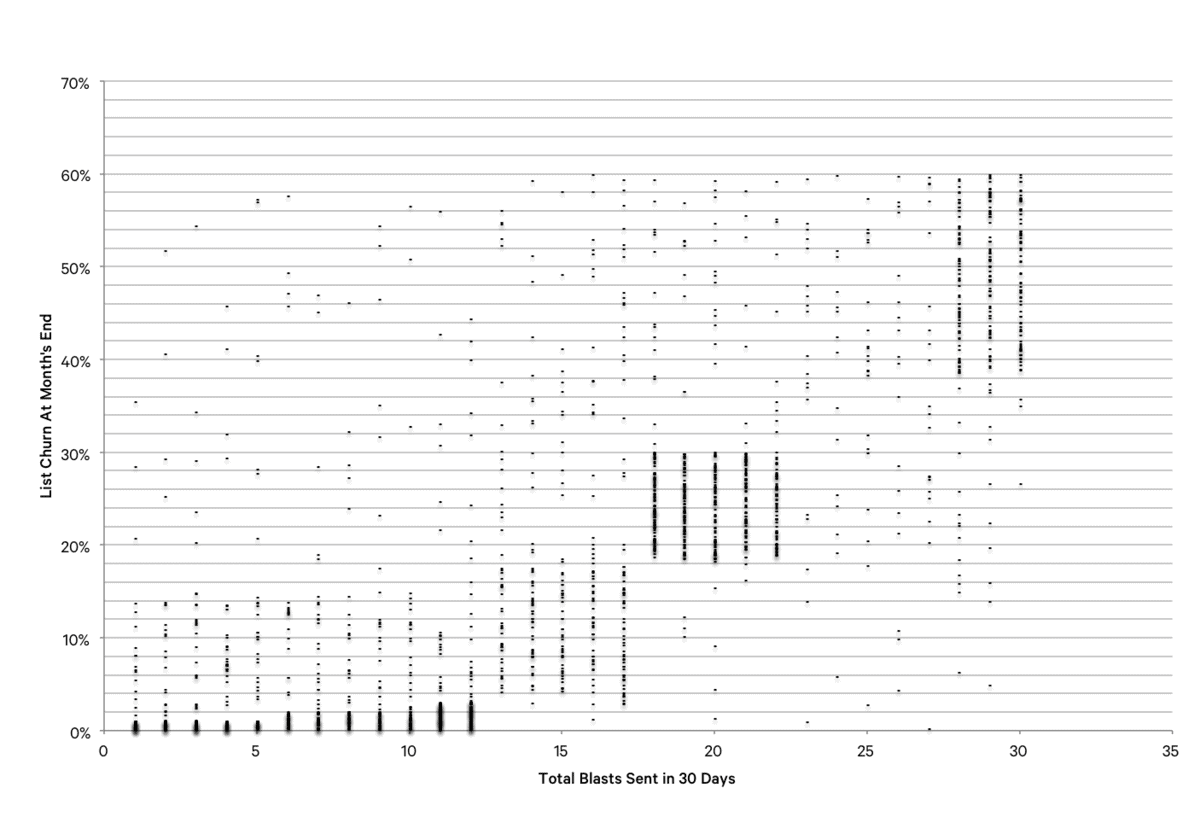
See those darker/thicker black bands? Those reflect common occurrences, a total blasts sent/unsubscribe rate combo likely to occur. Notice that unsubscribe rate tends to increase significantly once marketers send more than 10-15 SMS messages in a thirty-day period. Those sending more than 20 SMS messages in a month risk unsubscribe rates as high as 60%. Based on this graph, Blue could send potentially six more SMS messages (creating additional value) without risking a huge increase in unsubscribe rate. Orange should dial down his/her marketing frequency significantly in order to avoid the high cost that comes with acquiring customers.
At least, that’s the general trend. For marketers to find their own sweet spot, I’d advise starting with 4-5 SMS messages per month (between 1-2 SMS messages per week). Track success and experiment with increasing message frequency to ~10 SMS messages per month to see if you can increase value. If you want to go above 10-12, clearly communicate expectations to customers, provide a ton of value and never send more than one message in a day.
In other words: Execute. Review. Iterate. That’s the name of the game in mobile marketing. Like anything in life, each marketer has to discover his/her own specific success apex, which comes from an iterative approach to customer outreach.
Want a more in-depth look at your own SMS strategy? Now that you know the optimal SMS message frequency, see a quick demo of Upland Mobile Messaging.


